by Alastair Potts
I had the unusual pleasure of attending an awards ceremony for researchers and lecturers where the guest speaker,
Dr John Kani, berated us in an unstinting barrage of uncomfortable truth. His voice, as unique as that of Morgan Freeman, captivated us as he poured his scorn and derision upon the state of the country
— and how the universities are, in part, to blame. An interesting choice of topic to an event aimed at celebrating research, teaching and engagement
— but an entirely necessary call to arms.
So what did John Kani say? It was a wide ranging talk, but below are two of the highlights that stuck with me (Crucial note: I was not prepared for note taking
— it was an awards event after all
— and although I've remembered these points, they are [largely] in my own words):
- Scientists — what is it that you actually do? Dr Kani highlighted that scientists get so wrapped up in their private worlds [and usually only hang out with other scientists] that they forget to explain what it is they do and why it is important. But worse, we don't give much thought on how to make our research accessible to the lay person, or school children. We publish in rarefied journals that the even the most ardent of non-scientist science enthusiasts will a. battle to understand, and (even worse) b. won't have access to [locked behind publisher paywalls]. He shares the story of the selection committee for the prestigious Order of Mapungubwe battling to understand what it is that any given scientist has done that may warrant the bestowing of such an award. If we cannot (do not?) share our research findings with the public at large, then what is the point of science? I feel that this point is spot on: we cannot expect non-specialists to rise to the level of specialists (who have spent years learning the theory and jargon). It is the specialists who need to rise to the level of simplicity [Einstein had much to say about simplicity!].
- Universities — why are you so quiet? Another point that that he raised was that Universities have, in his view, shied away from politics and advising government. He makes a good point: where are the qualifications specially designed for councillors and others in public service? Surely it is the universities who have the responsibility to create the diploma and degree benchmarks to ensure that those in public service are qualified to serve the public. Dr Kani relates the historical narrative of the NATS gaining power, based on a large part to the argument of the Afrikaans culture being under threat of erosion or extinction — and within a few years (six?) it was possible to study from pre-primary all the way through to University in Afrikaans. The NATS did this by pouring money into this agenda — i.e. into Universities, the Arts etc. Dr Kani believes that no such effort, nor commitment, has been made by the current government, and that universities have accepted this. Universities have not made a strong enough call to demand to be the agents of change for the country. [Rather, the funding for universities has declined without much active outcry which led to the burden being passed onto students].
Dr Kani left us with a challenge: be the driving agents of change in South Africa. We have the most powerful tool available — education. Given the new name of Nelson Mandela University and the university's slogan, "Change the World", this message could not have come at a more appropriate time.
It is time to to turn the ivory towers into the pillars that support a better nation.







